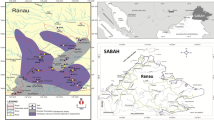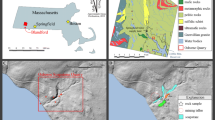Abstract
Ultramafic rocks and their related soils (i.e., serpentine soils) are non-anthropogenic sources of metal contamination. Elevated concentrations of metals released from these soils into the surrounding areas and groundwater have ecological-, agricultural-, and human health-related consequences. Here we report the geochemistry of four different serpentine soil localities in Sri Lanka by coupling interpretations garnered from physicochemical properties and chemical extractions. Both Ni and Mn demonstrate appreciable release in water from the Ussangoda soils compared to the other three localities, with Ni and Mn metal release increasing with increasing ionic strengths at all sites. Sequential extraction experiments, utilized to identify “elemental pools,” indicate that Mn is mainly associated with oxides/(oxy)hydroxides, whereas Ni and Cr are bound in silicates and spinels. Nickel was the most bioavailable metal compared to Mn and Cr in all four soils, with the highest value observed in the Ussangoda soil at 168 ± 6.40 mg kg−1 via the 0.01-M CaCl2 extraction. Although Mn is dominantly bound in oxides/(oxy)hydroxides, Mn is widely dispersed with concentrations reaching as high as 391 mg kg−1 (Yudhaganawa) in the organic fraction and 49 mg kg−1 (Ussangoda) in the exchangeable fraction. Despite Cr being primarily retained in the residual fraction, the second largest pool of Cr was in the organic matter fraction (693 mg kg−1 in the Yudhaganawa soil). Overall, our results support that serpentine soils in Sri Lanka offer a highly labile source of metals to the critical zone.






Similar content being viewed by others
References
Alexander, E. B. (2004). Serpentine soil redness, differences among peridotite and serpentinite materials, Klamath Mountains, California. International Geology Review, 46(8), 754–764.
Alves, S., Trancoso, M. A., Gonçalves, M. d. L. S., & Correia dos Santos, M. M. (2011). A nickel availability study in serpentinised areas of Portugal. Geoderma, 164(3–4), 155–163.
Amir, H., & Pineau, R. (2003). Release of Ni and Co by microbial activity in New Caledonian ultramafic soils. Canadian Journal of Microbiology, 49(4), 288–293.
Armienta, M. A., Rodríguez, R., Ceniceros, N., Juárez, F., & Cruz, O. (1996). Distribution, origin and fate of chromium in soils in Guanajuato, Mexico. Environmental Pollution, 91(3), 391–397.
Aydinalp, C., & Katkat, A. V. (2004). The comparison of extraction methods for evaluating some heavy metals in polluted soils. Plant Soil Environment, 50(5), 212–217.
Becquer, T., Quantin, C., Sicot, M., & Boudot, J. P. (2003). Chromium availability in ultramafic soils from New Caledonia. Science of the Total Environment, 301(1–3), 251–261.
Boyd, R. S., Kruckeberg, A. R., & Rajakaruna, N. (2009). Biology of ultramafic rocks and soils: research goals for the future. Northeastern Naturalist, 16(5), 422–440.
Brooks, R. R. (1987). Serpentine and its vegetation: a multidisciplinary approach. Portland: Dioscorides.
Camachoa, J. R., & Armientac, M. A. (2000). Natural chromium contamination of groundwater at Leo’n Valley, Mexico. Journal of Geochemical Exploration, 68, 167–181.
Castilho, P. D., & Rix, I. (1993). Ammonium acetate extraction for soil heavy metal speciation; model aided soil test interpretation. International Journal of Environmental Analytical Chemistry, 51(1–4), 59–64.
Cheng, C.–. H., Jien, S.–. H., Iizuka, Y., Tsai, H., Chang, Y.–. H., & Hseu, Z.-Y. (2011). Pedogenic chromium and nickel partitioning in serpentine soils along a toposequence. Soil Science Society of America Journal, 75(2), 659–668.
Coleman, R. G. (1977). Ophiolites: ancient oceanic lithosphere? Berlin: Springer.
Coleman, R. G., & Jove, C. (1992). Geological origin of serpentinites. In: A. J. M. Baker, J. Proctor, & R. D. Reeves (Eds.), The vegetation of ultramafic (serpentine) soils. Proceedings of the First International Conference on Serpentine Ecology (pp. 1–17). Hampshire: Intercept.
Cooray, P. G. (1984). An introduction to the geology of Sri Lanka (Ceylon). Colombo: National Museums of Sri Lanka.
Dissanayaka, C. B. (1982). The geology and geochemistry of the Uda Walawe serpentinite. Sri Lanka. Journal National Science Council Sri Lanka, 10, 13–34.
Dissanayake, C. B., & Van Riel, B. J. (1978). The petrology and geochemistry of a recently discovered nickeliferous serpentinite from Sri Lanka. Journal of the Geological Society of India, 19, 464–471.
Echevarria, G., Massoura, S. T., Sterckeman, T., Becquer, T., Schwartz, C., & Morel, J. L. (2006). Assessment and control of the bioavailability of nickel in soils. Environmental Toxicology and Chemistry, 25(3), 643–651.
Fendorf, S. E. (1995). Surface reactions of chromium in soils and waters. Geoderma, 67(1–2), 55–71.
Gasser, U. G., & Dahlgren, R. A. (1994). Solid-phase speciation and surface association of metals in serpentinitic soils. Soil Science and Plant Nutrition, 158, 409–420.
Gleyzes, C., Tellier, S., & Astruc, M. (2002). Fractionation studies of trace elements in contaminated soils and sediments: a review of sequential extraction procedures. TrAC Trends in Analytical Chemistry, 21(6–7), 451–467.
Gough, L. P., Meadows, G. R., Jackson, L. L., & Dudka, S. (1989). Biogeochemistry of highly serpentinized chromite rich ultramafic area, Tehma County, California. USGS Bulletin, 1901.
Gupta, S. K., & Aten, C. (1993). Comparison and evaluation of extraction media and their suitability in a simple model to predict the biological relevance of heavy metal concentrations in contaminated soils. International Journal of Environmental Analytical Chemistry, 51(1–4), 25–46.
Harris, T., & Rajakaruna, N. (2009). Adiantum viridimontanum, Aspidotis densa, Minuartia marcescens, and Symphyotrichum rhiannon: additional serpentine endemics from Eastern North America. Northeastern Naturalist, 16(sp5), 111–120.
Harrison, S., & Kruckeberg, A. R. (2008). Garden on the rocks. Natural History, 117, 40–44.
Harrison, S., & Rajakaruna, N. (2011). Serpentine: the evolution and ecology of a model system. Berkeley: University of California Press.
Houba, V. J. G., Lexmond, T. M., Novozamsky, I., & Lee, J. J. (1996). State of the art and future developments in soil analysis for bioavailability assessment. Science of the Total Environment, 178, 21–28.
Kabata-Pendias, A., & Pendias, H. (2001). Trace elements in soils and plants (3rd ed.). Boca Raton: CRC.
Kashem, M. A., Singh, B. R., Kondo, T., Imamul Huq, S. M., & Kawai, S. (2007). Comparison of extractability of Cd, Cu, Pb and Zn with sequential extraction in contaminated and non-contaminated soils. International Journal Environmental Science Technology, 4(2), 169–176.
Kukier, U., Peters, C. A., Chaney, R. L., Angle, J. S., & Roseberg, R. J. (2004). The effect of pH on metal accumulation in two alyssum species. Journal of Environmental Quality, 33(6), 2090–2102.
Langmuir, D. (1997). Aqueous environmental geochemistry. Englewood Cliffs: Prentice Hall.
Lindsay, W. L., & Norvell, W. A. (1978). Development of a DTPA soil test for zinc, iron, manganese, and copper. Soil Science Society of America Journal, 42(3), 421–428.
McGrath, S. P. (1995). Chromium and nickel. In B. J. Alloway (Ed.), Heavy metals in soils (pp. 152–174). London: Blackie Academic and Professional.
Mogollón, J. L., Pérez-Diaz, A., & Lo Monaco, S. (2000). The effects of ion identity and ionic strength on the dissolution rate of a gibbsitic bauxite. Geochimica et Cosmochimica Acta, 64(5), 781–795.
Morais, F. I., Page, A. L., & Lund, L. J. (1976). The effect of pH, salt concentration, and nature of electrolytes on the charge characteristics of Brazilian tropical soils. Soil Science Society of America Journal, 40, 521–527.
Munasinghe, T., & Dissanayake, C. B. (1980). Is the Highland-eastern Vijayan boundary in Sri Lanka a possible mineralized belt? Economic Geology, 75(5), 775–777.
Myers, N., Mittermeier, R. A., Mittermeier, C. G., da Fonseca, G. A. B., & Kent, J. (2000). Biodiversity hotspots for conservation priorities. Nature, 403(6772), 853–858.
O’Hanley, D. S. (1996). Serpentinites: records of tectonic and petrological history. Oxford monographs on geology and geophysics (34th ed.). New York: Oxford University Press.
Oze, C. (2003). Chromium geochemistry of serpentinites and serpentine soils. Stanford: Stanford University.
Oze, C., Fendorf, S., Bird, D. K., & Coleman, R. G. (2004a). Chromium geochemistry in serpentinized ultramafic rocks and serpentine soils from the Franciscan complex of California. American Journal Science, 304, 67–101.
Oze, C., Fendorf, S., Bird, D. K., & Coleman, R. G. (2004b). Chromium geochemistry of serpentine soils. International Geology Review, 46, 97–126.
Oze, C., Skinner, C., Schroth, A., & Coleman, R. G. (2008). Growing up green on serpentine soils: biogeochemistry of serpentine vegetation in the Central Coast Range of California. Applied Geochemistry, 23, 3391–3403.
Parks, G. A., & de Bruyn, P. L. (1961). The zero point of charge of oxides. The Journal of Physical Chemistry, 66, 967–973.
Peijnenburg, W. J. G., Zablotskaja, M., & Vijver, M. G. (2007). Monitoring metals in terrestrial environments within a bioavailability framework and a focus on soil extraction. Ecotoxicology and Environmental Safety, 67, 163–179.
Proctor, J., & Baker, A. J. M. (1994). The importance of nickel for plant growth in ultramafic (serpentine) soils. In S. M. Ross (Ed.), Toxic metals in soil–plant systems (pp. 417–432). Chichester: Wiley.
Rajakaruna, N., & Baker, J. M. (2004). Serpentine: a model habitat for botanical research in Sri Lanka. Ceylon Journal of Science (Biological Sciences), 32, 1–19.
Rajakaruna, N., & Bohm, B. A. (2002). Serpentine and its vegetation: a preliminary study from Sri Lanka. Journal of Applied Botany, 76, 20–28.
Rajakaruna, N., Harris, C. S., & Towers, G. H. N. (2002). Antimicrobial activity of plants collected from serpentine outcrops in Sri Lanka. Pharmaceutical Biology, 40(3), 235–244.
Rajakaruna, N., Harris, T. B., & Alexander, E. B. (2009). Serpentine geoecology of Eastern North America: a review. Rhodora, 111(945), 21–108.
Rajapaksha, A. U., Vithanage, M., Oze, C., Bandara, W. M. A. T., & Weerasooriya, R. (2012). Nickel and manganese release in serpentine soil from the Ussangoda ultramafic complex, Sri Lanka. Geoderma, 189–190, 1–9.
Ranasinghe, N. S. (1987). Serpentinites associated with the precambrian of Sri Lanka. Geological Society of Sri Lanka special publication no. 3. Colombo: Geological Survey Department.
Senevirathne, A. S., Nandadasa, H. G., Fernando, W. S., Sanjeevani, H. H. V. M., & Rajapakshe, R. L. H. R. (2000). The serpentine vegetation of Ussangoda (Hambantota District) and nickel accumulating plant species. Paper presented at the Proceedings of the Sixth Annual Forestry and Environmental Symposium, Kandy, Sri Lanka, 29–30 December.
Stumm, W., & Morgan, J. J. (1996). Aquatic chemistry. New York: Wiley Inter-Science.
Sucik, G., Hrsak, D., Fedorockova, A., & Lazic, L. (2008). The preliminary characterization of serpentinite from Ljeskovac locality in Croatia. Acta Metallurgica Slovaca, 14, 275–280.
Sun, Y.-c., Chi, P.-h., & Shiue, M.-y. (2001). Comparison of different digestion methods for total decomposition of siliceous and organic environmental samples. Analytical Sciences, 17(12), 1395–1399.
Tessier, A., Campbell, P. G. C., & Bisson, M. (1979). Sequential extraction procedure for the speciation of particulate trace metals. Analytical Chemistry, 51(7), 844–851.
Tye, A. M., Young, S., Crout, N. M. J., Zhang, H., Preston, S., Zhao, F. J., et al. (2004). Speciation and solubility of Cu, Ni and Pb in contaminated soils. European Journal of Soil Science, 55(3), 579–590.
Van der Ent, A., Baker, A. M., Reeves, R., Pollard, A. J., & Schat, H. (2013). Hyperaccumulators of metal and metalloid trace elements: facts and fiction. Plant and Soil, 362(1–2), 319–334.
Weerasinghe, H. A. S., & Iqbal, M. C. M. (2011). Plant diversity and soil characteristics of the Ussangoda serpentine site. Journal National Science Foundation Sri Lanka, 39(4), 355–363.
Acknowledgements
International Foundation for Science (Sweden) and Organization for the Prohibition of Chemical Weapons, The Hague, are kindly acknowledged for their funding (grant number W/5068-1). Authors thank Dr. J.C. Bailey at the Institute for Geography and Geology, University of Copenhagen and Dr. Steen Christensen and colleagues at the Department of Earth Sciences, University of Aarhus, Denmark for providing XRF results and Prof. Y. S. Ok at the Department of Biological Environment at Kangwon National University, South Korea for EPMA analysis.
Author information
Authors and Affiliations
Corresponding author
Rights and permissions
About this article
Cite this article
Vithanage, M., Rajapaksha, A.U., Oze, C. et al. Metal release from serpentine soils in Sri Lanka. Environ Monit Assess 186, 3415–3429 (2014). https://doi.org/10.1007/s10661-014-3626-8
Received:
Accepted:
Published:
Issue Date:
DOI: https://doi.org/10.1007/s10661-014-3626-8




